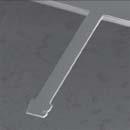Artificial finger opens window into the atomic world
Scientists in the US have developed an ’artificial fingertip’ that boosts the resolution of atomic force microscopy, a technique that opens a window onto the nanoscale world. The tip can also assess the mechanical properties of the surface, determining whether the substance is soft, stiff or sticky.
Atomic force microscopes work by moving a sharp tip along the surface, touching each atom one by one. The tip is mounted on a cantilever that jiggles as it moves over the surface, rather like the arm on a record player. This movement can be translated into a topographic map of the surface. But it’s a slow process, taking around one second per atom scanned.
Ozgur Sahin and colleagues at Harvard University, Cambridge, Massachusetts, have now improved the technique by applying lateral thinking to the existing design. Sahin told Chemistry World: ’The modification we made is rather simple. Conventional designs were always symmetrical - the sharp tip was placed in the centre of the cantilever. We moved the sharp tip to the very corner, which allows us to access and measure the twisting oscillations.’

Measuring the oscillations is computer-intensive, but the team has managed to increase the speed at which surfaces are mapped by a factor of 1000 as well as measuring forces at the surface. Since the AFM tip physically touches the surface, and different chemical components each have a different elastic modulus, any interactions can be related to the chemical composition of the material. To demonstrate this, the team observed the changes in two sheets of plastic as they were heated above 100?C, showing the transition from a stiff glass-like phase into a softer rubbery phase.
Robert Stark at Ludwig-Maximilians University, Munich, Germany, likens the AFM tip to a nano-scale finger that can truly feel the different forces on the surface. He told Chemistry World: I can see immediate applications in polymer science. The new method will definitely help to characterize co-polymers, for example. In the long run, I think that this method will be very helpful in AFM-based nanorobotics.’
Saul Tendler at the University of Nottingham, UK, added: ’AFM provides us with access to information that is very difficult to access by other means. Improving the resolution and getting mechanical information about the surface will definitely be helpful in looking at larger proteins and DNA.’
Sahin’s team report that the new tips are already in the ’beta’ phase of production and should be available on the market by the end of this year.
Lewis Brindley
References
O. Sahin et al, Nat. Nanotech., 2007 (DOI: 10.1038/nnano.2007.226)






No comments yet